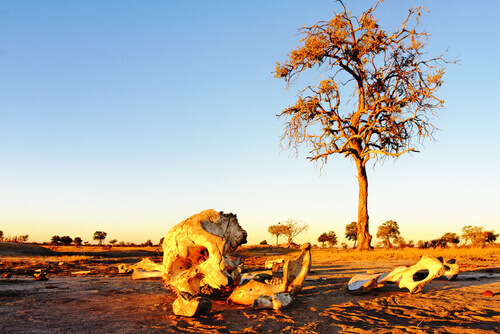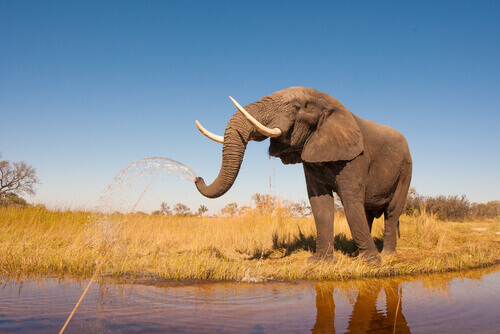Elephant Graveyards: Myth or Reality?

Throughout history, people have been fascinated by the possible existence of elephant graveyards, supposedly a specific place where African elephants go to die. During the European colonial era in the ancient continent, the myth was very popular and many people searched for these sites.
The reason for this was economic. Ivory in those days–and still today–is very valuable, so finding an elephant graveyard would have been like stumbling upon El Dorado in America.
What are elephant graveyards?
As the name suggests, elephant graveyards are a place with a large number of carcasses of these animals. The location of these sites is a complete mystery, considered a myth even before European civilizations set foot on the continent.
According to African tribal myths, elephants separate from the group when they feel that death is coming for them, so as not to be a burden and slow down the herd. And they go to a special site, where no human has ever been, to die in peace.
Of course, when Europeans heard this story, they began to search for these pachyderm ‘crypts’. They were interested in the elephant’s tusks, which are made of ivory. Ivory is a precious mineral used as decoration for various types of jewelry.
However, as with El Dorado, no trace of these elephant cemeteries has ever been found in Africa. And to this day it remains a mystery that fuels the imagination through stories. Some people believe they can’t be found because they’re protected by ancient gods and millenary guardians.

The facts
Consider the size of the African savannahs and deserts: we’re talking about a huge area, and a big crowd of these animals doesn’t seem possible. Elephants are migratory, and it’s common for herds to travel long distances to places with lots of food and water.
This is why it’s unlikely elephant graveyards exist on the continent; the animals are constantly on the move to perpetuate the existence of their species. It’s common to see two to five carcasses at a single site, but more than this number is very unusual.
Any group of carcasses of the same animal is usually due to the effects of nature or to humans. Changes in climate, droughts and indiscriminate hunting can cause the appearance of these ‘cemeteries’, but there’s no evidence that these elephants have a designated place to die or bury their dead.
One example from nature is in Lake Rudolf in Kenya; the lake is extremely salty and has probably poisoned many herds of elephants over the years. Because of this, it’s common to find large numbers of skeletons on its shore.
The wind also influences the location of the bones. In what way? Well, the strong winds of the savannahs can sweep bones away from their carcass.
Elephants are highly intelligent and thus very curious animals. It’s actually common to see an elephant stand in front of the bones of a family member and ‘pay its respects’ to the deceased.

Myth or reality?
The fairest thing to say about elephant graveyards is that we’re talking about a half-truth. It’s not true that these animals have a specific place that they go to to die; any accumulation of their corpses is due to coincidence.
Several carcasses are often found together in one place, but never in large numbers as the myth claims. In fact, any groups of carcasses are likely due to the environmental conditions of the area or indiscriminate hunting.
Despite this, some people still believe that elephant cemeteries exist in the ancient continent. In fact, they’ve been the inspiration for some interesting film productions throughout the 20th century.
- They’re referenced in at least two films: One is the original Tarzan from 1938, where the plot revolves around the search for one of these sacred sites. Another is The Lion King, which has a well-known scene set in an elephant cemetery.
- The Bolivian movie El Cementerio de los Elefantes revolves around this idea, but in this case it’s the name of a bar where marginalized men go to spend their days drinking and lamenting.
This text is provided for informational purposes only and does not replace consultation with a professional. If in doubt, consult your specialist.